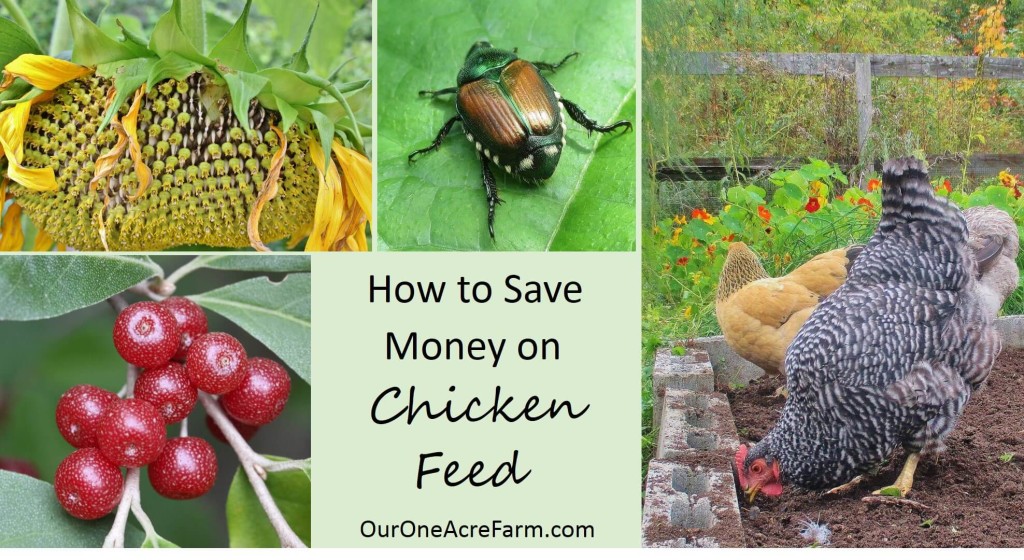 Chickens are happier and their eggs are more healthful when the birds are allowed to forage for a variety of foods within a diverse habitat. But because free ranging is dangerous, most flock masters rely on commercial feed for most of the flock’s nutrition. These balanced but boring feeds are expensive and comprised of foods produced in environmentally damaging monocultures. But you can save money on chicken feed, give your hens variety and opportunity to express their natural behaviors, reduce dependence on industrial monocultures, and improve the quality of their eggs by supplementing with “natural” and healthful foods. Here’s how.
Chickens are happier and their eggs are more healthful when the birds are allowed to forage for a variety of foods within a diverse habitat. But because free ranging is dangerous, most flock masters rely on commercial feed for most of the flock’s nutrition. These balanced but boring feeds are expensive and comprised of foods produced in environmentally damaging monocultures. But you can save money on chicken feed, give your hens variety and opportunity to express their natural behaviors, reduce dependence on industrial monocultures, and improve the quality of their eggs by supplementing with “natural” and healthful foods. Here’s how.
Save Money on Chicken Feed with Natural, Healthful Alternatives
I hate using the word “natural” to imply that some other food isn’t natural. After all, everything ultimately comes from nature, including the contents of a bag of commercial chicken feed. But here I am using the word “natural” to refer to less processed foods which are produced in more diverse ecosystems. That is, ecosystems which better mimic naturally occurring, complex ecosystems. So here, the distinction between “unnatural” and “natural” reflects the distinction between conventional agriculture and permaculture. (Read Permaculture Principles to learn how food is grown in systems which mimic natural ecosystems.) So now that I’ve got that out of the way, I’ll go on to describe how you can cut the cost of chicken feed and provide natural alternatives to chickens kept at various levels of confinement.
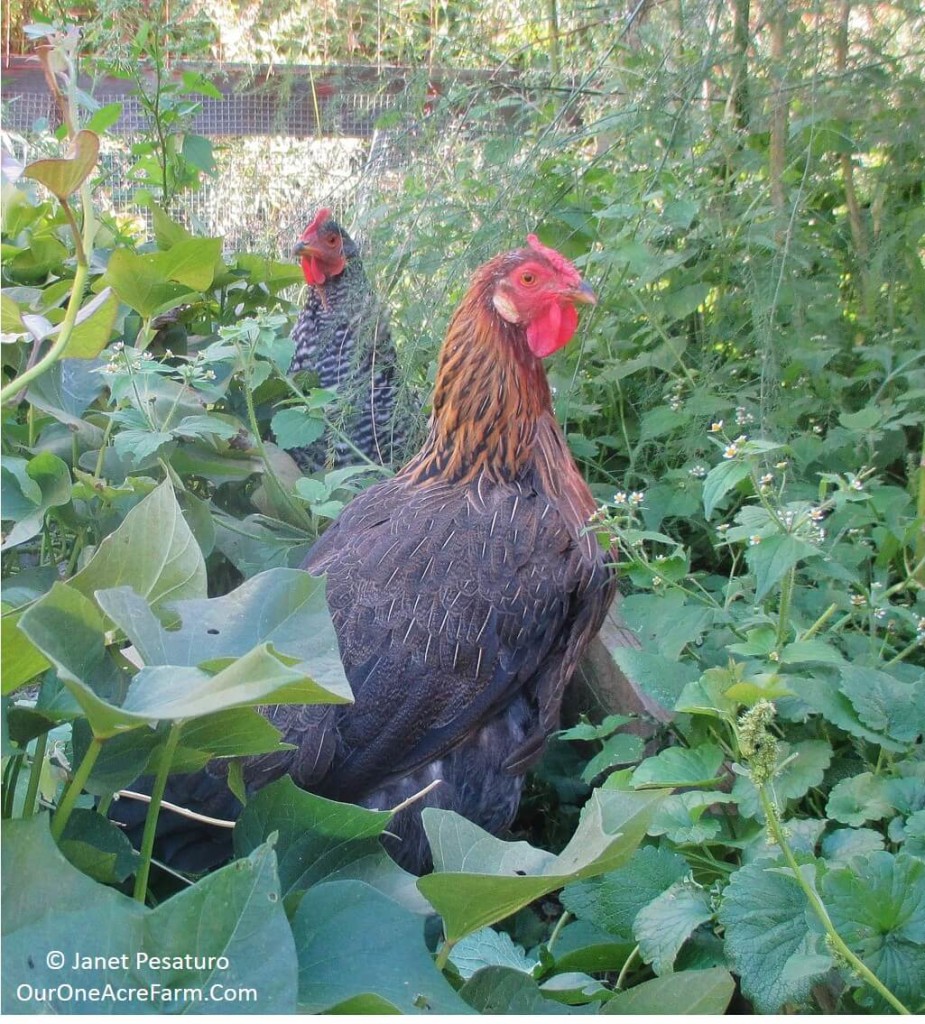
In late summer, we give the flock access to the vegetable garden so they can eat what they can reach. Luckily, they ignore sweet potato leaves, which are in the foreground.
Feed them from your vegetable garden and orchard
Full sized chickens can devastate a vegetable garden, especially when plants are young. We exclude them from our garden with a 4 ft fence, but open the gate to give them access between late summer and early spring. We close them out as soon as spring planting begins. We don’t do much fall planting, and simply protect what little we do plant (like garlic). By late summer, much of our produce is already harvested or too high up for chickens to reach. Whatever they can reach, they’re welcome to take. You can see a diagram of our set-up, including vegetable garden, compost bins, fruit trees, and chicken yard, in this post: Limited Free Range Chickens.
When chickens must be confined, food from the garden and orchard can be delivered to them. We give them almost anything that we don’t want, and find that they appreciate any and all of the following:
- Excess produce that I don’t have time to preserve
- Young vegetable thinnings (lettuces, Asian greens, kale, carrots, beets, turnips, etc.)
- Weeds (don’t bother to shake the dirt off the roots, and chickens will pick through the dirt to find worms and insects)
- Garden pests, such as Japanese beetles and various caterpillars (I dump Japanese beetles into a container of water and let the chickens gobble them up right out of the containers)
- Small, poorly developed, bruised, and/or blemished produce, such as squash, tomatoes, and corn.
- Small, poor, or fallen fruit
- Sunflower seeds (which I leave on the seed heads as a free for all, both chickens and wildlife)
Some people go all out and plant a garden specifically for their chickens, but we just feed them the excess, the weeds, and the pests from ours.
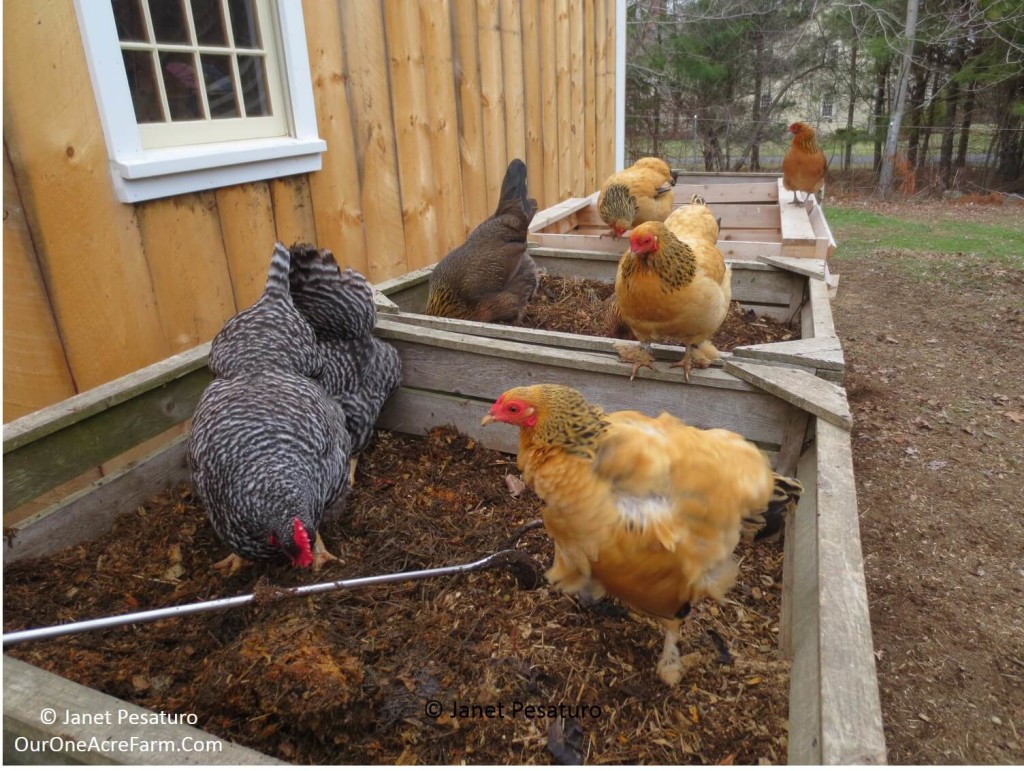
Here, my flock is excited about the freshly aerated compost. You have to turn compost periodically to bring worms and other invertebrates close enough to the surface for chickens to find.
Give chickens access to compost bins or piles
Our chickens take great pleasure in foraging through compost piles. The compost bins are located in the chicken yard for their enjoyment. Everyday when I let them out into the yard, they run to the compost to see “what’s new”. There’s nothing like fresh vegetable scraps from the kitchen and weeds from the garden.
Chickens don’t need to free range or have access to a large fenced yard in order to benefit from the compost. Some people put the compost bin right in the chicken run, and others don’t even have a bin. They simply throw many of their compostibles – vegetable scraps, weeds, leaves, and grass clippings – into the chicken run and let the chickens work it.
One thing I will point out, though. You’ll read here and there that chickens will do the work of turning a compost pile for you. Not exactly true. If the pile is not contained within a bin, it won’t be a pile for very long after you set the chickens on it, for they will spread it out flat in no time. If the compost is in a bin, they’ll scratch around at the surface but they’re too small to aerate the deeper portion. And while it is not absolutely necessary to turn and aerate, doing so has benefits beyond hastening the composting process. It discourages rodents from making their homes in it, and it brings some of the earth worms and other tasty decomposing organisms to the surface, so chickens can find them. There’s not much worm and insect activity going on at the surface of a static pile. I use a compost aerator up to twice a week to pull some of the deeper, active compost up to the surface for chickens to enjoy.
Other kitchen waste
As omnivores, chickens benefit from animal proteins, just like you do. Excess dairy products can be fed to chickens, (but only in moderation, because chickens cannot digest lactose). Excess eggs can be cooked, shell and all, and fed to chickens. DO NOT feed them whole, raw eggs, because they will soon learn to eat them right out of the nest boxes, and you won’t get any. Chopped or ground cooked meat is also fair game for chickens. Mine have enjoyed all of these.
Some people object to feeding chickens these animal foods, but there is no biologic basis for that. Chickens are omnivores, and will catch and eat animal foods when they can. They will eat anything from tiny insects to small snakes, toads, mice, etc.

Two hens are vying for possession of a piece of leftover corn on the cob.
Grow hydroponic green fodder for chickens
“Fodder” simply refers to food for livestock. You can grow grains, vegetables, or fruits to supplement their diet, as chickens are omnivores and can eat almost anything you eat. There is no need to do this during the warmer months if they have access to good habitat outdoors, but in cold winter areas, chickens welcome a break from dry pellets in the form of fresh, green vegetable matter. Hydroponic green fodder is a nutritious and inexpensive way to provide that. That said, it doesn’t reduce dependence on conventional monocultures unless you grow your own grains and seeds.
Hydroponic green fodder refers to grains and other seeds sprouted in water and grown until green appears. At least that’s what it means in the technical literature (1). Unfortunately, “fodder” in some of the popular literature refers specifically to hydroponic sprouted grain with several inches of green growth. These sites define “sprouts” as hydroponic sprouted grain with less than several inches of green growth.
Regardless of terminology, these are the advantages to sprouting grain hydroponically:
- It’s a cheap way to give chickens the pleasure of green forage during the winter months.
- It increases the availability of B vitamins, vitamin C, folate, fiber, and essential amino acids (2).
- It’s a way to grow food for animals without using precious garden space.
Hydroponic sprouting is not something I have personal experience with, so I offer you this video showing how to do it. I chose this video from among several because it’s briefer and very well presented:
If you research growing “sprouts” and “fodder” for chickens, you’ll find some disagreement over the optimal length of green growth. One school of thought says several inches of growth (“fodder”) is best because the longer growing period increases nutrient availability. But the other side cautions against feeding longer pieces of grass because, they believe, it can cause crop impaction. Quite honestly, I don’t think either are true.
The study I found suggests that younger sprouts are actually more nutritious than older ones (3). As for longer pieces of grass causing crop impaction? That’s probably not an issue, because you feed sprouted green fodder as a mat, not in individual strands of grass. Chickens bite off pieces, just like they bite pieces of grass from a lawn or pasture. But I’d go with younger sprouts anyway, for better nutrition.
Raise worms or grubs
As omnivores, chickens relish many types of insects, grubs, and worms (not to mention animals like small snakes, toads, and mice). If your chickens do not have access to habitat with these protein rich delicacies, and you don’t mind the disgust factor, you could raise any of these creepy crawlies to the delight of your flock:
- Earthworms – Check out Harvey Ussery’s article on vermicomposting (4)
- Mealworms, the larval stage of the darkling beetle. Peak Prosperity has an excellent article on that (5)
- Soldier grubs – Check out Harvey Ussery’s article on this (6)
To bypass most of the grossness, take the easy way out, like me, and purchase dried mealworms. I feed these in small quantity as a protein rich treat, especially in winter when worms and bugs are otherwise unavailable.
Foraging for chickens
If your chickens cannot go out to forage, you can forage for them. Harvest grasses and weeds from your yard or from the wild. No need to spend a lot of time or make a production of this. Give them grasses and herbs in messy handfuls, and don’t bother to pick berries clean. Just bring them berry laden branches or clusters. I give mine a lot of autumn olive branches and some elderberry clusters, because those grow nearby in relative abundance. Here are some other wild foods my hens enjoy:
- Yellow wood sorrel (a great favorite of my birds, from young chicks to old hens)
- Dandelion seed heads (my hens rarely touch the leaves)
- Clover and lamb’s quarters are eaten to some extent
- Grasses, especially if in seed
- Grapes (mine don’t eat them unless I smoosh them first, expelling the soft interior, making it easier for them to grasp)
- Berries: blueberries, elderberries, raspberries, blackberries, and autumn olive berries. My hens have shown no interest in chokeberries or hawthorn berries.
- Hickory nuts and hazelnuts (let husks dry till they fall off, crush shells with a stone or hammer, and chickens will pick out the nuts)
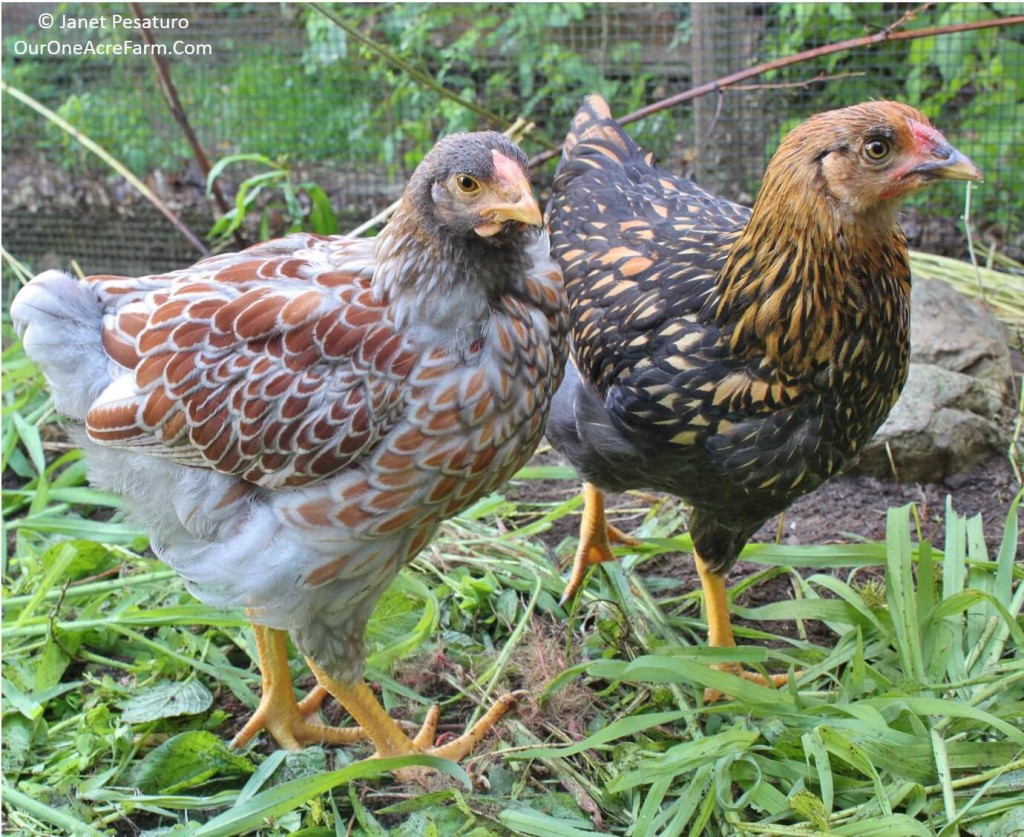
Too young and flighty to be contained within our 4 ft fence, these pullets are confined to a pen for now. To keep them entertained, I bring them buckets of weeds picked from the garden and foraged from the wild, and toss them right into the pen.
Make your own chicken feed
It may or may not be cheaper to mix your own chicken feed. This recipe for organic homemade chicken feed looks great, but you’d have to add up the cost of the ingredients available in your area to see if you’d actually save money. Fermenting the feed increases nutritional value, thus reducing the amount of feed needed to sustain the flock, and you can learn to do this here. Mixing and fermenting might save money on chicken feed, but don’t reduce reliance on environmentally damaging monocultures, unless you grow your own grain.
Grocery store and restaurant waste
Some grocery stores will donate over-ripe, wilted, or bruised produce to farms to feed farm animals, which is a great way to reduce waste. A friend of mine feeds her pigs with old produce from a local farm stand, and I’m sure chickens would appreciate it especially in winter. I have read of chickens raised on restaurant scraps, which seems like a great way to reduce waste, but I’d be concerned about high quantities of salt and refined carbohydrates in most restaurant food. I’m not sure how well can chickens handle the high dietary salt, in particular. Salty foods like leftover pizza are just an occasional treat for my flock.
Sources
- Bakshi, M. P. S. and Wadhwa, M. 2015. Recent Advances in Animal Nutrition. Satish Serial Publishing House.
- Sprouted Whole Grains (from WholeGrainsCouncil.org)
- Peer, D. J. and Leeson, S. 1985. Nutrient content of hydroponically sprouted barley. Animal Feed Science and Technology. 13(3-4) 191-202.
- Raising Earthworms to Feed the Flock (by Harvey Ussery)
- Raising Mealworms for Chickens (from Peak Prosperity)
- Cultivating Soldier Grubs to Feed the Flock (by Harvey Ussery)
How do you save money on chicken feed? What are your cost cutting secrets? Feel free to share your comments and ask questions below!
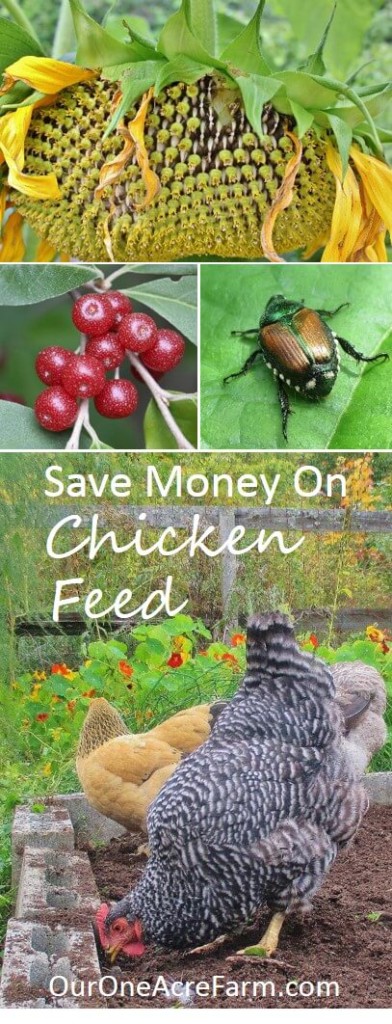
Please pin THIS image!











We do this. Our birds are fed a mix of all of these things and I have an awesome recipe that you can find on my blog for feed. All of our livestock is fed naturally including our rabbits. Thank you for the ideas. I’m going to print this article to keep handy.
Hi Victoria,
I’m impressed that you feed all of your livestock naturally – Does that mean you don’t use any commercial feed at all? That is amazing – and wonderful! I’m glad you found this post helpful, and will check out your blog. Thanks for stopping by!
Janet
Your chickens are beautiful! Ours love digging through the compost. They free range on a good 2.5 acre area but we still raise mealworms for winter time especially. Never considered setting out thinned vegetable plants for them. I hate thinning plants… This year I didn’t do it on my outdoor plants but maybe I’ll do it next year and feel better knowing it’s providing nutrition for my chickens.
Wow, ranging over 2.5 acres must make for wonderfully happy chickens! Ours have much less space, but I think there’s a enough plant life within that space to keep them reasonably occupied. I admire you for raising mealworms – I just can’t bring myself to do it. Thanks for stopping by!
You didn’t have free chickens and roosters right
Hi Janet,
I live here in Bolton and would love to visit your one acre farm. Would you show me around sometime and point out a few of the wild berries etc. that you gather? We no longer have chickens (we are getting old) but I love your blog and have tried to live as you do here in Bolton for over 40 years. We are certainly similar thinkers a generation apart!
Hi Sallyann. Just replied via email in case you don’t check back here.
-Janet
Hi Janet!
I’m a total chicken newbie and your articles are super helpful!
I have a walnut tree and a couple of crabapple trees. Can I feed them the walnuts and crab apples? I don’t want to poison my babies!
Hi Sarah, I think it’s fine to feed them crabapples and walnuts as long as they have access to many other foods and/or balanced chicken feed. Everything in moderation. You wouldn’t want to feed them only crabapples and walnuts, but as part of a balanced diet, they should be fine. Glad you found the article helpful!
So I can plant sweet potatoes in their grazing area and not worry about them eating them?
I’m a newbie too and love my 4 hens!
Judy, I am not sure. I have read that some people feed their chickens chopped sweet potato leaves, but mine have always ignored them in the garden. It may be that they have access to foods they like better, and where they don’t have better alternatives, they’d eat the sweet potato leaves.
Where is the one acre farm located?
In Massachusetts, Keith.
How do you make sure the chickens are getting the right nutrition. I love the idea of feeding them a more natural diet. But I worry I would not offer the right variety of things to get them what they need.thanks for your input
Always make balanced layer feed available to them, whether you buy commercial feed, or make your own, and then offer a variety of other foods, each in moderation. Don’t give them large quantities of one or two foods, for example, wherein they have no choice but to survive only those few items. Chickens are omnivores, and will self regulate, given access to enough variety (like humans and many other omnivores).
If they have some time to free range in good habitat, that can only help, because they will find a variety of plant and invertebrate foods.
Access to compost with plant matter, worms and other invertebrates, is virtually always a good thing, as well. If all they have is layer feed and that, they will be fine. If, on the other hand, all you give is pasta or watermelon (for example), they will become malnourished.
I raised free-range chickens for many years. During the warm months, they never had boughten food. Free range supplied all they wanted. Clean water daily is a must. I always shut them inside a building at night or they would be killed by owls, skunks, minks, oppossums, etc. Having a couple roosters will protect them from hawks, foxes, etc. during the day. In the winter, I fed laying mash or crumbles and whole oats, for healthy plumage. The most aggressive roosters I’ve had are any red color, Rhode Island and its relatives are the worst. Barred roosters are also frequently agressive. Raising chicks and spending time with them develops a calmer pet. I have had many show quality chickens from Murray McMurray hatchery.
The first photo on this article shows a couple of hens poking their heads up amongst the greenery. Can you please tell me the breed of the rosecombed lacey gold necked one in front? I have a younger one that looks exactly the same but unsure what it is. Thanks!
She is a rose comb brown leghorn, a slender breed that lays white eggs.
This looks helpful.
Would you be able to tell me about how many chickens you had when you produced this video? We have roughly 18 chickens and 3 adult (Champagne D’Argent) rabbits and I’m wondering how the amount of fodder we would need compares to what you were growing. Your video is, to me, more informative and clear than any others I’ve seen on this topic.
Thanks!
Lila
Hi victiriya very good show this hydrophonic
Did you make your compost bins in the chicken yard or buy assembled? I want to do this!
We bought them as kits and assembled in the backyard